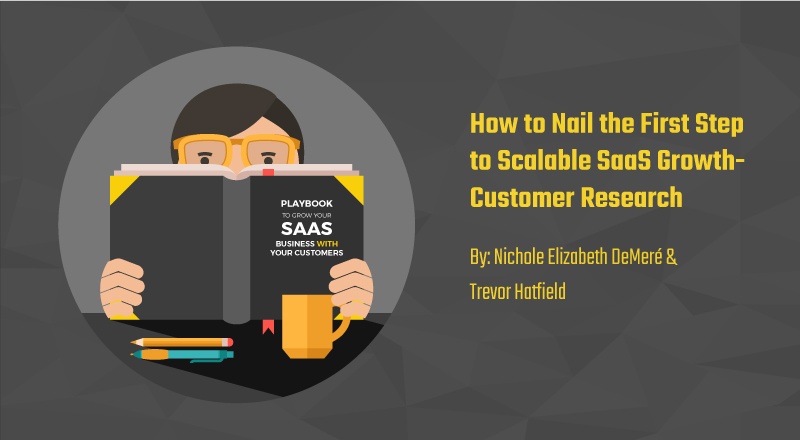
By Nichole Elizabeth DeMeré & Trevor Hatfield
We’re in the midst of writing our SaaS Growth Playbook – a zero bullshit, actionable guide to growing SaaS businesses that are set up to scale from the start. It’s an ambitious undertaking, because so much has been written about this. Really great books like The Startup Owner’s Manual (currently highlighted and bookmarked past recognition on our desks), The Lean Startup and Lean Analytics, Value Proposition Design, and that whole “Jobs to be Done” thing? Is that a book yet? Because it seems like every founder we’ve spoken with in the last two months can’t stop talking about it.
Yes, there are a lot of good ideas out there. Great ideas, even. But that’s the thing. There are so many ideas. What we’re doing is taking the ideas we know work – because we’ve seen them work time and again in real businesses we’ve consulted for – and explaining them clearly, quickly and actionably. With zero fluff – because ain’t nobody got time for that.
At the core of all of these methodologies (and what we’re writing) is this:
Getting to know your customer really, really well.
And that is hard. For any size business. It’s as hard as it is vitally important, because everything you do, from developing your product, to marketing your product, to creating a brand that drives customers to you – it all starts here.
So few startups get this right.
And established companies? They get this wrong all the time.
Take Campbell’s Soup, for example. Few brands are as established as Campbell’s Soup. That red and white label, immortalized by Andy Warhol no less, is iconic. And they ditched it. Recently (you may have noticed?).
They completely rebranded their labels in an effort to appeal to their new target audience: Millennial moms. So they took inspiration from Pinterest and Tumblr and made these really weird microwavable packets with faces on them.

Weird, right? But that’s what companies do when they want to be “hip” without actually asking the people they’re trying to be “hip” for what they want.
It turns out, Tumblr-like labels didn’t hit the mark. What Millennial moms really wanted was a change inside the can. Clean, whole ingredients. Once Campbell’s realized that, it changed their marketing entirely and the result was refreshingly relevant.

Now, most of us don’t have Campbell’s Soup kind of money. But we can all aspire to do customer research before investing in a re-brand – right folks?
That’s what this is about. Saving money by doing the hard thing first – talking to your customers to find out what they want.
But first, you have to define who, exactly, you need to talk to.
And that starts by developing a hypothesis.
The Hypothetical Customer
 “I think my customers are ________. The problem they have that I can solve is _________.”
“I think my customers are ________. The problem they have that I can solve is _________.”
Go ahead, take a stab at it.
“I think my customers are SaaS founders. The problem they have that I can solve is too much conflicting information and no guarantee that the pages filling up their bookshelves actually work.”
That is our working hypothesis for our book.
If you have a few types of customers you intend to serve, come up with a hypothesis for each segment.
This is the easy part! You’ve created or at least ideated your company with a customer and solution in mind. Now comes the hard part: Validating your hypothesis, or chucking it into the bin.
Most books spend hundreds of pages circling around this topic. We know, we’ve highlighted the good stuff. But what it comes down to is this.
- List everyone you know who falls into the category of customer you’ve just described. List everyone you don’t know personally, but seem like they would fall into the category of customer you’ve just described. See if you can come up with a list of 20 people.
- Now, email each of those people and ask to set up a 15 minute call. Or, if they’re local, you can sit down with them in person and buy them a cup of coffee. Make it clear you’re not selling anything, and that you value their expertise and time. And, if you’re shy about asking for a favor, thank them with a Starbucks gift card or trade some of your expertise and time. Reciprocity isn’t just a marketing hack – it’s important in all stages of business.
- Ask them these three things:
1. What jobs do you need to do around [what your industry/product/problem is]? Have them walk you through their process and record the exact words they use. For example, if you’re selling an HR solution that helps companies hire qualified people faster online (shoutout to Vervoe!), the tasks a business owner, manager or HR person need to do is create a job posting, sort through resumes, figure out interview questions, and spend hours interviewing people.
2. What’s hard about those jobs? Let them rant about how hard they work and what grinds their gears, how they’ve failed or got outcomes they didn’t want. Record everything.
3. If those issues were magically solved – what do they love about their jobs? What would they love about their lives? What would solving that problem allow them to do with that time instead?
Sure, there are a million and more questions you could ask – but these three focus on what jobs these customers need to do, what their pain points are surrounding those jobs, and what their ideal outcomes are.
We’re using a little of the Startup Owner’s Manual, a little Lean, a little Jobs to be Done, a dash of Customer Success – and a lot of experience here.
The answers you gain will start to show you some truths about your hypotheses.
- You’ll start to see that some kind of ‘ideal customers’ are more ideal than others.
- You’ll check whether the problems they have match the problems you think they have.
- You’ll compare the language you use to describe those jobs and problems with the language they use.
- And you’ll uncover insights you can’t even begin to guess at right now.
You may have to go back to the drawing board and re-write your ideal customer hypothesis – and that’s okay. It’s progress.
And you’ll definitely come away with language you can use for marketing – it’s one of the most valuables takeaways of this exercise.
Don’t be Lazy
Why can’t you just send a survey? Hey, that’s the reaction of most founders, too. Really. If we all agreed to just keep things simple by communicating via text message and Slack, we’d have more time for everything else. But believe us when we say: You need to hear their words.
In person, if possible.
Yes, it takes time and it’s nerve-wracking and uncomfortable. But it’s worth it. People will not tell you on a survey what they will say to your face. They won’t even tell an employee of yours the same thing they’ll tell you, the founder. With an actual conversation, you’ll be able to ask in-the-moment follow-up questions, listen to the tone of their answers and put their words into an emotional context, and most importantly – you’ll be starting a relationship with potentially ideal customers who might become your first customers. Your best customers. Customers that will adopt early and advocate for you.
All of this comes from person-to-person communication. You can’t survey it away.
Keep it Short
A few rules for polite customer research:
- Keep it short – stick to 15 or 20 minutes. It’s enough to get deep information without scaring people away.
- Make sure every question you ask is actionable – as in, if you don’t plan to act on the information you get, don’t waste time asking the question.
- Avoid yes/no questions. The goal is to get voice-of-customer data, which means you need to let them speak and not put words into their mouths.
- Don’t take anything personally. These people want solutions to their problems, and maybe you have them, but even if you don’t, they’re giving you valuable feedback.
- Show appreciation somehow. This doesn’t need to be fancy or expensive, but it should be personal and helpful.
Sort Your Answer Pile
In the course of customer research, you’ll speak with people who may have seemed like ideal customers at first, but then clearly were not.
And others who aren’t so clear. They could go either way.
The answers you need most are the ones from your ideal clients, and to make sure you’re sorting the Ideals from the Non-Ideals accurately, ask yourself this:
- If I gave this person my product/service/solution, could they successfully use it to reach their ideal outcomes.
This is a Customer Success approach that I really like because it sets you up to work with people who are primed and ready to love your product (and tell their friends about it). It’s also a way to avoid The Product Death Cycle of customer churn, panic, product changes and bankruptcy.

Success Potential relies on several different types of “fit” that the customer has to have to be able to use your product/service and reach their ideal outcomes. Types of fit include:
- Technical – They have or can get the right technology to use your product.
- Functional – Your product offers the features the customer needs to achieve their ideal outcome.
- Resource – They have the time, money or manpower to use your product.
- Competence – They know or can learn what they need to know to be successful with your product.
- Cultural – They share your core values, without which you wouldn’t work well together.
- Experience – You are able to deliver your product in the way they need to succeed, like having a Customer Success agent assigned to them if they need a high-touch approach, or clear in-app walkthroughs if they prefer to DIY. It’s about providing an appropriate experience that gives them support, in the way they need to be supported, to succeed.
There are other types of fit too, and you should feel free to build your own list and keep adding to it as you grow. Understanding fit now will go a long way towards preventing churn, and understanding churn when it happens.
You’ll be returning to your customers for feedback again and again – and if you don’t know which customers to ask, that feedback can get you into trouble! That’s why we’re spending a lot of time on laying the foundations that are so important to building a sustainable, scalable business. At the end of the day, it’s not about what you know – it’s who you know, and how well you know them.
Get Early Access
Take the guesswork out of growth and get our Playbook to Grow Your Saas Business With Your Customers.



